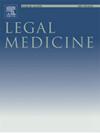Analytical pit-holes in the determination of carboxyhemoglobin saturation in thermally denatured coagulated blood samples
IF 1.4
4区 医学
Q3 MEDICINE, LEGAL
引用次数: 0
Abstract
In the field of forensic toxicology, deaths related to carbon monoxide (CO) inhalation is one of the most relevant concerns. A common method for measuring CO-hemoglobin (Hb) saturation in blood is to measure the absorbance with a spectrophotometer. We recently encountered a fire case in which there appeared a large discrepancy between the autopsy findings and CO-Hb saturation, where the coagulated blood clots filling the heart and large blood vessels showed CO-Hb saturation of about 80% (CO poisoning level), but no soot was found in the bronchial tubes of the remaining body. We suspected this discrepancy to be caused by the application of spectrophotometry, which normally is applied to liquid blood sample, but in this case was applied to thermally coagulated blood. In this study, firstly we heated blood at various temperatures and times to investigate whether thermally coagulated blood clots were formed or not. Furthermore, CO-Hb saturation was measured in the coagulated blood clots using spectrophotometry to verify the discrepancy between the autopsy findings and CO-Hb saturation in the present case. The results show that CO-Hb saturation in coagulated blood clots that had undergone thermal denaturation and coagulation did not reflect the original values, in particular, blood samples with low CO-Hb saturation can show high CO-Hb saturation that may indicate CO poisoning. When determining cause of death, therefore, CO-Hb saturation value determined by spectrophotometer should be used with caution.
热变性凝固血液样品中碳氧血红蛋白饱和度测定中的分析缺陷。
在法医毒理学领域,与一氧化碳(CO)吸入有关的死亡是最相关的问题之一。测量血中血红蛋白(Hb)饱和度的常用方法是用分光光度计测量吸光度。我们最近遇到了一个火灾病例,尸检结果与CO- hb饱和度出现了很大的差异,心脏和大血管中凝结的血凝块显示CO- hb饱和度约为80% (CO中毒水平),但在其余身体的支气管中未发现煤烟。我们怀疑这种差异是由于分光光度法的应用引起的,分光光度法通常应用于液体血液样本,但在这种情况下应用于热凝固血液。在这项研究中,我们首先在不同的温度和时间下加热血液,观察是否形成热凝血块。此外,使用分光光度法测量凝固血凝块中的CO-Hb饱和度,以验证尸检结果与本病例CO-Hb饱和度之间的差异。结果表明,经过热变性和凝固的凝血块中CO- hb饱和度并没有反映出原始值,特别是CO- hb饱和度较低的血液样本可以显示出较高的CO- hb饱和度,这可能表明CO中毒。因此,在确定死因时,应谨慎使用分光光度计测定的CO-Hb饱和值。
本文章由计算机程序翻译,如有差异,请以英文原文为准。
求助全文
约1分钟内获得全文
求助全文
来源期刊

Legal Medicine
Nursing-Issues, Ethics and Legal Aspects
CiteScore
2.80
自引率
6.70%
发文量
119
审稿时长
7.9 weeks
期刊介绍:
Legal Medicine provides an international forum for the publication of original articles, reviews and correspondence on subjects that cover practical and theoretical areas of interest relating to the wide range of legal medicine.
Subjects covered include forensic pathology, toxicology, odontology, anthropology, criminalistics, immunochemistry, hemogenetics and forensic aspects of biological science with emphasis on DNA analysis and molecular biology. Submissions dealing with medicolegal problems such as malpractice, insurance, child abuse or ethics in medical practice are also acceptable.
 求助内容:
求助内容: 应助结果提醒方式:
应助结果提醒方式:


